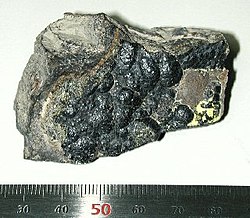Francium
Francium is a chemical element with the chemical symbol Fr and an atomic number of 87. It is a metal. In chemistry it is placed in a group of metal elements named the alkali metals. Francium is very radioactive. It is in very small amounts in uranium and thorium ores. It has the lowest electronegativity and electron affinity of all the chemical elements.
| General properties | ||||||||||||||||||||||||||||||
|---|---|---|---|---|---|---|---|---|---|---|---|---|---|---|---|---|---|---|---|---|---|---|---|---|---|---|---|---|---|---|
| Pronunciation | /ˈfrænsiəm/ | |||||||||||||||||||||||||||||
| Mass number | 223 (most stable isotope) | |||||||||||||||||||||||||||||
| Francium in the periodic table | ||||||||||||||||||||||||||||||
| ||||||||||||||||||||||||||||||
| Atomic number (Z) | 87 | |||||||||||||||||||||||||||||
| Group | group 1 (alkali metals) | |||||||||||||||||||||||||||||
| Period | period 7 | |||||||||||||||||||||||||||||
| Block | s-block | |||||||||||||||||||||||||||||
| Element category | alkali metal | |||||||||||||||||||||||||||||
| Electron configuration | [Rn] 7s1 | |||||||||||||||||||||||||||||
Electrons per shell | 2, 8, 18, 32, 18, 8, 1 | |||||||||||||||||||||||||||||
| Physical properties | ||||||||||||||||||||||||||||||
| Phase at STP | Fr: Solid | |||||||||||||||||||||||||||||
| Melting point | 300 K (27 °C, 81 °F) | |||||||||||||||||||||||||||||
| Boiling point | 950 K (677 °C, 1251 °F) | |||||||||||||||||||||||||||||
| Density (near r.t.) | 2.48 g/cm3 (estimated)[1] | |||||||||||||||||||||||||||||
Vapor pressure (extrapolated)
| ||||||||||||||||||||||||||||||
| Atomic properties | ||||||||||||||||||||||||||||||
| Oxidation states | +1 (a strongly basic oxide) | |||||||||||||||||||||||||||||
| Electronegativity | Pauling scale: >0.79 | |||||||||||||||||||||||||||||
| Ionization energies |
| |||||||||||||||||||||||||||||
| Covalent radius | 260 pm (extrapolated) | |||||||||||||||||||||||||||||
| Van der Waals radius | 348 pm (extrapolated) | |||||||||||||||||||||||||||||
| Other properties | ||||||||||||||||||||||||||||||
| Natural occurrence | Fr: From decay | |||||||||||||||||||||||||||||
| Crystal structure | body-centered cubic (bcc) (extrapolated) | |||||||||||||||||||||||||||||
| Thermal conductivity | 15 W/(m·K) (extrapolated) | |||||||||||||||||||||||||||||
| Electrical resistivity | 3 µΩ·m (calculated) | |||||||||||||||||||||||||||||
| Magnetic ordering | Paramagnetic | |||||||||||||||||||||||||||||
| CAS Number | 7440-73-5 | |||||||||||||||||||||||||||||
| History | ||||||||||||||||||||||||||||||
| Naming | after France, homeland of the discoverer | |||||||||||||||||||||||||||||
| Discovery and first isolation | Marguerite Perey (1939) | |||||||||||||||||||||||||||||
| Main isotopes of francium | ||||||||||||||||||||||||||||||
| ||||||||||||||||||||||||||||||
Francium reacts violently with water, as do all of the elements in group 1 on the periodic table.
Francium is one of the hardest to find elements on the planet Earth. It is estimated that there are only about 15 grams or half an ounce in the Earth's crust at a single time.[3]
Although chemists knew the element number 87 in the periodic table should exist, it was a long time before it was discovered. In the early 1900s, nearly all boxes on the periodic table had been filled. Chemists knew that one element had been found to fit into each box. Francium was discovered in 1939 by a French chemist called Marguerite Perey.[3] She named it after her home country, France.
Isotopes
There are 34 known isotopes of francium ranging in atomic mass from 199 to 232. Francium-223 and francium-221 are the only isotopes that occur in nature.
Francium-223 is the most stable isotope, with a half-life of 21.8 minutes. Francium-223 is the fifth product of the actinium decay series as the daughter isotope of actinium-227. Francium-223 then decays into radium-223 by beta decay (1.149 MeV decay energy), with a minor (0.006%) alpha decay path to astatine-219 (5.4 MeV decay energy).
Francium-221 has a half-life of 4.8 minutes. It is the ninth product of the neptunium decay series as a daughter isotope of actinium-225. Francium-221 then decays into astatine-217 by alpha decay (6.457 MeV decay energy).
Francium Media
This sample of uraninite contains about 100,000 atoms (3.7×10−17 g) of francium-223 at any given time.
References
- ↑ Lavrukhina, Avgusta Konstantinovna; Pozdnyakov, Aleksandr Aleksandrovich (1970). Analytical Chemistry of Technetium, Promethium, Astatine, and Francium. Translated by R. Kondor. Ann Arbor–Humphrey Science Publishers. p. 269. ISBN 978-0-250-39923-9.
- ↑ ISOLDE Collaboration, J. Phys. B 23, 3511 (1990) (PDF online)
- ↑ 3.0 3.1 "Francium, Chemical Element". Chemistry: Foundations and Applications - Elements. Advameg, Inc. Retrieved 2008-11-21.

